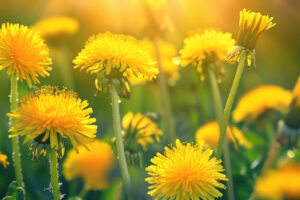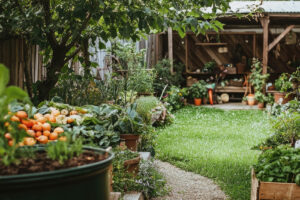“Sleep, Creep, and Leap” is often used by gardeners to describe the development of plants over multiple seasons. This three-phase cycle — commonly associated with perennials, trees, and shrubs — illustrates how plants establish themselves gradually before experiencing significant growth. Understanding this natural progression helps us make wise planting decisions.
I developed my food forest over several years, mainly because the sandy soil in our yard needed to be built up first, but also so I could observe a couple of seasons of growth before I committed to what worked here. This time of observation and experimentation took patience, but eventually paid off. It also allowed a few newly established trees to leap into a growth phase just as I was ready to form guilds (companion plants that support the tree’s growth) beneath them. That said, even when you have a plan in mind, know that it will change. Being flexible as this natural progression plays out is part of the wonder and joy of gardening.
Perennial plants can take several seasons to mature, but once they do, they will return from their established root system year after year under the proper growing conditions. My favorites are evergreen, but some plants that go dormant or die back in the winter are worth the patience, also earning their place of value in the yard.
In my north central Florida food forest, my favorite evergreens are avocado trees, loquats, guavas, and citrus. I also have chomolia perennial kale, rosemary, mint, and society garlic that keep my garden green year-round and it’s easy to see the three-year cycle in their development. But I also have trees and bushes that go dormant like my pomegranates, persimmon, and stone fruits. With them, the sleep phases can at times seem agonizingly slow, but the sleep phase applies every winter.
Each year, I cover fewer plants, and most recover well once spring arrives. Each year, they seem to bounce back faster and fuller than the year before.
Intentional choices during these natural phases benefit the healthy development of the food forest system and are well worth understanding and embracing.

The Three Stages of Plant Growth
1. The First Year of Development: Sleep
- Root Development: During the first year after planting, most of a plant’s energy is focused on developing a strong root system rather than producing foliage or flowers. This phase can often be mistaken for stunted growth, but it is a crucial foundation for long-term health. PATIENCE IS KEY here. Don’t give up on plants in their first year. Most simply need patience and a little extra care in the first year as they grow in ways we can’t see.
- Soil Adaptation: Plants adjust to their new environment by acclimating to soil conditions, nutrient availability, and moisture levels. Proper soil preparation and consistent watering during this initial stage are critical.
- Signs of the Sleep Phase: Minimal leaf or stem growth, slow response to environmental changes, and lower-than-expected blooming or fruiting.
- Care Tips for the Sleep Phase:
- Water regularly but avoid overwatering to prevent root rot.
- Mulch around the base to retain moisture and regulate temperature.
- Avoid heavy pruning and allow the plant to adjust to its new home.
NOTE: If a young tree flowers or fruits in this phase, it is best to remove any fruit that develops. While painful, it will promote a stronger, healthier plant in the long run. By removing fruit, you prevent the plant from putting energy toward fruit development, allowing it to focus on growing a vigorous root system instead.
TIP: When first developing a food forest, experimenting with container gardening can be a great way to discover how light levels and other growing conditions affect various plants. They can be easily rearranged until the ideal location is determined.
2. Creep: The Second Year of Growth
- Gradual Above-Ground Growth: By the second year, plants will start to produce more foliage and extend their branches. While the root system continues to grow, above-ground development becomes more noticeable.
- Increased Nutrient Uptake: As roots establish themselves, they become more efficient at absorbing water and nutrients, leading to stronger plant structure and resilience. You can stop babying your plant. They will begin to fend for themselves, becoming hardier in the process.
- Signs of the Creep Phase: More leaf production, some increase in stem length and diameter, improved resistance to environmental stressors, and occasional flowering.
- Care Tips for the Creep Phase:
- Apply organic fertilizers or compost to enhance nutrient supply.
- Prune selectively to shape the plant and encourage balanced growth.
- Keep an eye out for pests and diseases as plants become more vulnerable with increased foliage.
NOTE: You might see some blooms, but the plant is still getting established and should not be allowed to fruit yet. With patience, we can reap a greater reward in coming years by allowing the tree to grow stronger.
3. Leap: The Third Year and Beyond
- Rapid Growth and Maturity: By the third year, plants enter their “leap” phase, where they leap ahead in size and productivity. This is when trees, shrubs, and perennial plants reach their full potential in terms of flowering, fruiting, or foliage development.
- Established Resilience: Plants become more self-sufficient, requiring less intensive care. Their root systems are deep and strong, allowing them to access nutrients and water more effectively.
- Signs of the Leap Phase: Significant height increase, abundant flowers and fruit production, and overall vigorous appearance.
- Care Tips for the Leap Phase:
- Regular pruning to maintain shape and health.
- Deep watering during dry periods.
- Ongoing soil amendments to ensure proper nutrient balance. Incorporate organic matter like compost, manure, chop and drop, and cover crops.

Factors Influencing the Growth Cycle
- Plant Species and Varieties
- Some perennials and trees naturally take longer to establish than others. Slow-growing species may have an extended sleep phase, while fast growers may enter the leap phase earlier.
- Soil Conditions
- Well-draining, nutrient-rich soil encourages quicker establishment, while poor soil can delay the creep and leap stages.
- Climate and Weather
- Harsh winters or extreme droughts can prolong the sleep phase, whereas favorable conditions promote faster growth.
- Watering and Fertilization
- Consistent watering and appropriate fertilization can support plant health through each phase, ensuring a successful transition from sleep to leap.
- Pruning and Maintenance
- Proper pruning techniques can encourage faster growth and prevent structural weaknesses in trees and shrubs.
Each garden has its own unique challenges: soil issues, rainfall levels, light availability, growing area limitations, various climate and micro-climate factors to name a few.
After a rough winter with sudden or drastic temperature changes, some plants die back to the ground and come back from the roots. It’s painful, but with each year, the sleep phase can also apply to winter — and with many, they will make slower than the three-year progress, but progress nonetheless.
Some plants will thrive for decades or even longer with minimal care once they are established. Others will need to be divided or pruned to continue at their best.

Benefits of Understanding the Sleep, Creep, Leap Cycle
- Realistic Expectations: Set achievable goals for plant development
- Improved Plant Care: Tailor maintenance strategies to the plant’s current stage of growth
- Long-Term Success: Investment in plant health for future rewards
Conclusion
By understanding the natural Sleep-Creep-Leap rhythm of plant growth, we can better support our food forests’ needs, allowing them to become well established and productive in their own time. Patience and proper care during each phase will ultimately lead to a thriving edible landscape for years to come.
Copyright © 2025 Fruitful Food Forestry & Lauren Lynch. No portion of the original content on this website may be reproduced, in any language, without express written consent.









Leave a Reply
Your email is safe with us.